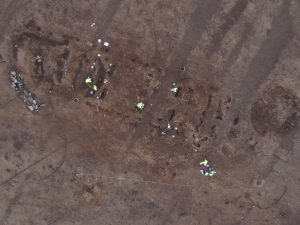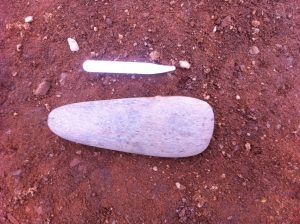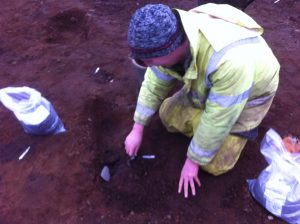
Aerial shot of Carnoustie Neolithic Hall – the axehead was found near the top left centre of the hall
Buried within one of a row of pits within the large Neolithic hall at Carnoustie was a complete axehead in pristine condition, quite possibly never used. Measuring 170 mm long and 63.5 mm wide, this was analysed by Alison Sheridan from National Museums Scotland. With one face more markedly convex than the other (the blade lies closer to the less convex face), in theory this could have been hafted as an adze-head instead of an axehead, although it lacks the marked longitudinal asymmetry of adze-heads.

Neolithic stone axehead
There are numerous shallow striations all over the surface, from its grinding smooth and polishing to a low sheen. There is no obvious haft stain, and in any case the position of the axehead in the pit indicates that it was unhafted when deposited. The stone has kindly been identified by Dr Peder Aspen (former curator of the Cockburn Geological Museum at the University of Edinburgh) as a garnet-albite-schist, a metamorphic rock originating in the Highlands.

Finding the Neolithic stone axehead
Stone axeheads were an essential tool of farming communities, and many will have been required in the construction of the large Early Neolithic timber buildings at Carnoustie. It is possible that the deposition of what appears to be an unused axehead in a pit was a symbolically-significant act for the Early Neolithic household here.
